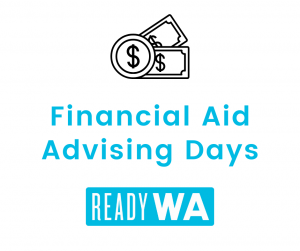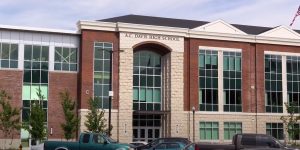 Navigating financial aid for education or training after high school can seem complicated and overwhelming. But national research shows that 90% of students who complete a financial aid application attend college and that the main reason students do not complete one is they think it’s too complex or they are not eligible for aid. Millions of financial aid dollars are left unclaimed each year by Washington’s seniors who could get help!
Navigating financial aid for education or training after high school can seem complicated and overwhelming. But national research shows that 90% of students who complete a financial aid application attend college and that the main reason students do not complete one is they think it’s too complex or they are not eligible for aid. Millions of financial aid dollars are left unclaimed each year by Washington’s seniors who could get help!
Financial aid opens the door to more affordable post-high school options that can lead to well-paying jobs in Washington state. In fact, in our state, the majority of job openings will be filled by workers who earn a credential after high school, such as a degree, apprenticeship or certificate.
The need to break down barriers for more students to access financial aid and post-high school education is a major reason why the state legislature added this requirement. All districts with a high school must connect 12th graders with an opportunity for financial aid advising through a Financial Aid Advising Day, notification about financial aid opportunities, and the High School and Beyond Planning process.
The goal of the Financial Aid Advising Day (FAAD) is to give all seniors the knowledge to apply for financial aid to help reduce costs associated with education and training after high school.
Filling out a financial aid form is the first step to accessing all kinds of financial aid, including the Washington College Grant, a need-based grant that does not need to be repaid.
What do Financial Aid Advising Days look like?
School districts must, by December 1 each year, provide a FAAD, or series of days, that include the following opportunities for current seniors:
- Information about financial aid sources and applications, including the Washington College Grant and the Free Application for Federal Student Aid (FAFSA), the Washington Application for State Financial Aid (WASFA) and the College Board’s CSS Profile.
- Assistance with completing the FAFSA or WASFA, as appropriate and whenever possible.
- A demonstration of how to use Washington’s Financial Aid Calculator.

At AC Davis High School in Yakima, students have multiple opportunities built into their days to learn about financial aid options and get support with their applications.
Jim Kindle, Davis’ college and career readiness specialist, said the school is all in to ensure students get what they need to pursue financial aid and prepare for next steps after high school.
One of the critical messages Kindle shares with students: “There’s money available to do this, whether it’s a four-year, two-year, or technical school. Be ready for it. Apply for it, and know that you have that opportunity in front of you.”
Last year, Davis students couldattend virtual financial aid help sessions every Tuesday and Thursday afternoon to get personalized assistance. The school also had virtual advising sessions on Tuesday mornings, which is an opportunity to check in about college and career planning.
Davis also has hosted two FAFSA/WASFA completion events. Seniors received a survey in advance asking where they are in their financial aid form process – information that Kindle and his team used to cater their support to individual students’ needs.
In partnership with school counselors and community-based organizations, seniors then joined virtual breakout rooms depending on the next step they needed to take with their application.
For seniors who had not started an application yet, the breakout room included discussion about post-high school education and training options, and the value that such credentials afford in terms of career opportunities.
Virtual financial aid support takes extra resources in terms of people power, Kindle said. “We need a ton of people available in this environment, because we need to keep students engaged. It’s much harder to build relationships.” To that end, Davis works with several community-based partners, as well as leaning on a “very involved staff.”
Some of the lessons that Davis has learned as it has moved college and career support online include the importance of “amped up communication” and celebrating small successes. When students were in the school building, they were more of a captive audience, Kindle noted. Virtually, it became more important to communicate incentives for students to stay on their computer to work on financial aid applications.
As for marking the successes, Kindle said, “When you look at completion report and see that five kids completed the application on their own, we celebrate that.”
On the other side of the state, staff at Grays Harbor College are also working hard at providing virtual opportunities for students to complete financial aid forms. When Recruitment/Admissions Manager Marcy Alstrom heard about FAAD requirements, she saw it as an opportunity for her team to support the already substantial workload of high school counselors.
“This is something the local community college can take a big role in the lift of organizing the resources,” Alstrom said. “It’s a service we can provide to students and to counselors.”
Since then, Alstrom has worked very closely with the 12th Year Campaign, an effort of the Washington Student Achievement Council, to make virtual financial aid events available to students in Grays Harbor and Pacific counties.
“It’s been a great opportunity to think about how to leverage these statewide resources, and use them to our community’s benefit,” Alstrom said.
As they work to increase event attendance and participation, Alstrom and her peers are continuing to evolve their outreach practices, including providing more content in Spanish, focusing on areas where financial aid form completion is lower, and opening events to any community member interested in learning more about financial aid.
Alstrom added that parents are a powerful network – “this information is important for their students’ communities,” she said.
Plus, holding virtual events enables a face-to-face connection of sorts, and it helps make tangible the connection between sometimes overwhelming financial aid forms and an actual postsecondary institution.
“The one-on-one conversations are really valuable,” Alstrom said. “We talk about the process, the importance of financial aid. It opens a whole world of opportunities.”
What if students and families need more help?
Several resources exist to support students and families in learning about financial aid and completing the application form:
- The 12th Year Campaign is offering several virtual work sessions that students can attend to get individualized assistance. Sign up here.
- The new Washington State Student Loan Education Site provides learning modules to help families better understand education costs and considerations.
- Otterbot is a free texting service created to support high school seniors who have signed up for the College Bound Scholarship. Otter sends financial aid info and reminders to College Bound seniors. Get started by texting “Hi Otter” to 360-928-7281.
- Find more information about the FAFSA and WASFA, financial aid opportunities, what to do if your financial circumstances have changed, and more from the Washington Student Achievement Council.
For districts: You can set up your Financial Aid Advising Day to make it most relevant to students and their families. And, there’s help available – read the Office of Superintendent of Public Instruction’s bulletin, and check out the 12th Year Campaign’s website, which includes videos, sign up information for virtual financial aid events, and much more.
If you’re a parent: ask your student about when Financial Aid Advising Day is happening at their school, and about financial aid generally.